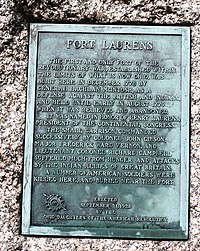Fort Laurens
This article lacks reliable sources. (March 2019) ) |
Fort Laurens Site | |
 Southwest bastion outline in ground | |
| Location | Lawrence Township, Tuscarawas County, Ohio |
|---|---|
| Nearest city | Bolivar, Ohio |
| Coordinates | 40°38′20″N 81°27′22″W / 40.63889°N 81.45611°W |
| Built | 1778 |
| NRHP reference No. | 70000518 [1] |
| Added to NRHP | November 10, 1970 |
Fort Laurens was an
Overview
The fort was built by General Lachlan McIntosh, in early December, 1778, on the west bank of the Tuscarawas River, now in Tuscarawas County near the town of Bolivar. It was named after Henry Laurens, a president of the Continental Congress from South Carolina. The fort was used as a reference point in defining the boundary line in Treaty of Greenville, although the text of the treaty misspells the name as "Fort Lawrence".
The fort was intended to be a staging point for an attack against the British garrison at
The fort was abandoned on August 2, 1779.
Siege
The British learned of the miserable conditions at the fort, and on February 22, 1779, Captain Henry Bird of the
The British forces were also weakened by the long siege and lifted the siege on March 20, 1779. American relief forces from Fort Pitt arrived three days later, leaving a force of 106 men behind under the command of Major Frederick Vernon. Colonel Daniel Brodhead had replaced McIntosh as commander at Fort Pitt and felt the fort was inadequate for mounting an attack on Fort Detroit.
Fort Laurens Museum & Park

The Ohio History Connection owns the site, and the Zoar Community Association operates the small museum at the site on behalf of OHC. The museum's exhibits include information on frontier soldiers, a video about the fort's history, and archaeological artifacts from the fort's excavation. The museum is located in a large park that is used for military reenactments. The fort is the site of the Tomb of the Unknown Patriot of the American Revolution, laid to rest with full military honors by the Ohio National Guard in 1976. A crypt in the museum wall also contains remains of soldiers who died defending the fort. The site is closed in the winter.
In 1970, the fort site was listed on the National Register of Historic Places.[1]
References
- ^ a b "National Register Information System". National Register of Historic Places. National Park Service. April 15, 2008.


